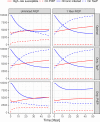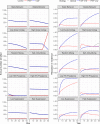Sensitivity of joint contagiousness and susceptibility-based dynamic optimal control strategies for HIV prevention
- PMID: 30335855
- PMCID: PMC6193630
- DOI: 10.1371/journal.pone.0204741
Sensitivity of joint contagiousness and susceptibility-based dynamic optimal control strategies for HIV prevention
Erratum in
-
Correction: Sensitivity of joint contagiousness and susceptibility-based dynamic optimal control strategies for HIV prevention.PLoS One. 2019 Feb 7;14(2):e0212251. doi: 10.1371/journal.pone.0212251. eCollection 2019. PLoS One. 2019. PMID: 30730987 Free PMC article.
Abstract
Predicting the population-level effects of an infectious disease intervention that incorporate multiple modes of intervention is complicated by the joint non-linear dynamics of both infection transmission and the intervention itself. In this paper, we consider the sensitivity of Dynamic Optimal Control Profiles (DOCPs) for the optimal joint investment in both a contagiousness and susceptibility-based control of HIV to bio-behavioral, economic, and programmatic assumptions. The DOCP is calculated using recently developed numerical algorithms that allow controls to be represented by a set of piecewise constant functions that maintain a constant yearly budget. Our transmission model assumes multiple stages of HIV infection corresponding to acute and chronic infection and both within- and between-individual behavioral heterogeneity. We parameterize a baseline scenario from a longitudinal study of sexual behavior in MSM and consider sensitivity of the DOCPs to deviations from that baseline scenario. In the baseline scenario, the primary determinant of the dominant control were programmatic factors, regardless of budget. In sensitivity analyses, the qualitative aspects of the optimal control policy were often robust to significant deviation in assumptions regarding transmission dynamics. In addition, we found several conditions in which long-term joint investment in both interventions was optimal. Our results suggest that modeling in the service of decision support for intervention design can improve population-level effects of a limited set of economic resources. We found that economic and programmatic factors were as important as the inherent transmission dynamics in determining population-level intervention effects. Given our finding that the DOCPs were robust to alternative biological and behavioral assumptions it may be possible to identify DOCPs even when the data are not sufficient to identify a transmission model.
Conflict of interest statement
The authors have declared that no competing interests exist.
Figures





Similar articles
-
PrEP as a feature in the optimal landscape of combination HIV prevention in sub-Saharan Africa.J Int AIDS Soc. 2016 Oct 18;19(7(Suppl 6)):21104. doi: 10.7448/IAS.19.7.21104. eCollection 2016. J Int AIDS Soc. 2016. PMID: 27760682 Free PMC article.
-
[Study on the infectious risk model of AIDS among men who have sex with men in Guangzhou].Zhonghua Liu Xing Bing Xue Za Zhi. 2012 Jul;33(7):667-71. Zhonghua Liu Xing Bing Xue Za Zhi. 2012. PMID: 22968013 Chinese.
-
PrEP for key populations in combination HIV prevention in Nairobi: a mathematical modelling study.Lancet HIV. 2017 May;4(5):e214-e222. doi: 10.1016/S2352-3018(17)30021-8. Epub 2017 Feb 21. Lancet HIV. 2017. PMID: 28233660
-
[Application of " Internet Plus" AIDS prevention services among men who have sex with men in Guangzhou, China: results from 2010 to 2015].Zhonghua Yu Fang Yi Xue Za Zhi. 2016 Oct 6;50(10):853-857. doi: 10.3760/cma.j.issn.0253-9624.2016.10.004. Zhonghua Yu Fang Yi Xue Za Zhi. 2016. PMID: 27686761 Chinese.
-
How Many HIV infections may be averted by targeting primary infection in men who have sex with men? Quantification of changes in transmission-risk behavior, using an individual-based model.J Infect Dis. 2014 Dec 1;210 Suppl 2(Suppl 2):S594-9. doi: 10.1093/infdis/jiu470. J Infect Dis. 2014. PMID: 25381380 Free PMC article.
Cited by
-
Correction: Sensitivity of joint contagiousness and susceptibility-based dynamic optimal control strategies for HIV prevention.PLoS One. 2019 Feb 7;14(2):e0212251. doi: 10.1371/journal.pone.0212251. eCollection 2019. PLoS One. 2019. PMID: 30730987 Free PMC article.
References
Publication types
MeSH terms
Grants and funding
LinkOut - more resources
Full Text Sources
Medical

